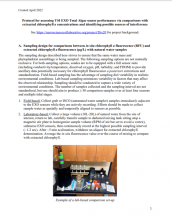
Standardized protocols for sensor-based chlorophyll monitoring are now available for use by staff around the system to implement high frequency chlorophyll monitoring at their reserves.
Concentrations of the photosynthetic pigment chlorophyll a are used as a proxy for phytoplankton biomass by estuarine scientists and managers to study eutrophication, food web dynamics, and harmful algal blooms. Traditionally, chlorophyll has been measured by filtering a water sample and extracting pigments from the filter in a laboratory, which is the current practice employed by the NERRS in monthly grab samples; however, monthly measurements are not sufficient for tracking plankton dynamics, which fluctuate hourly.
Twelve biogeochemically diverse reserves participated in a one-year study funded by the NERRS Science Collaborative. Protocols for calibration and data management were standardized and both chlorophyll methods (extractions and in situ sensor readings) were conducted at various frequencies for approximately one year. Given technician experiences with preliminary sensor deployments and results from previous studies, one objective of this project was to identify possible sensor interferences and develop standardized empirical correction procedures. Another objective of this project was to test how well extracted chlorophyll a could be predicted from the suite of YSI EXO sensors.